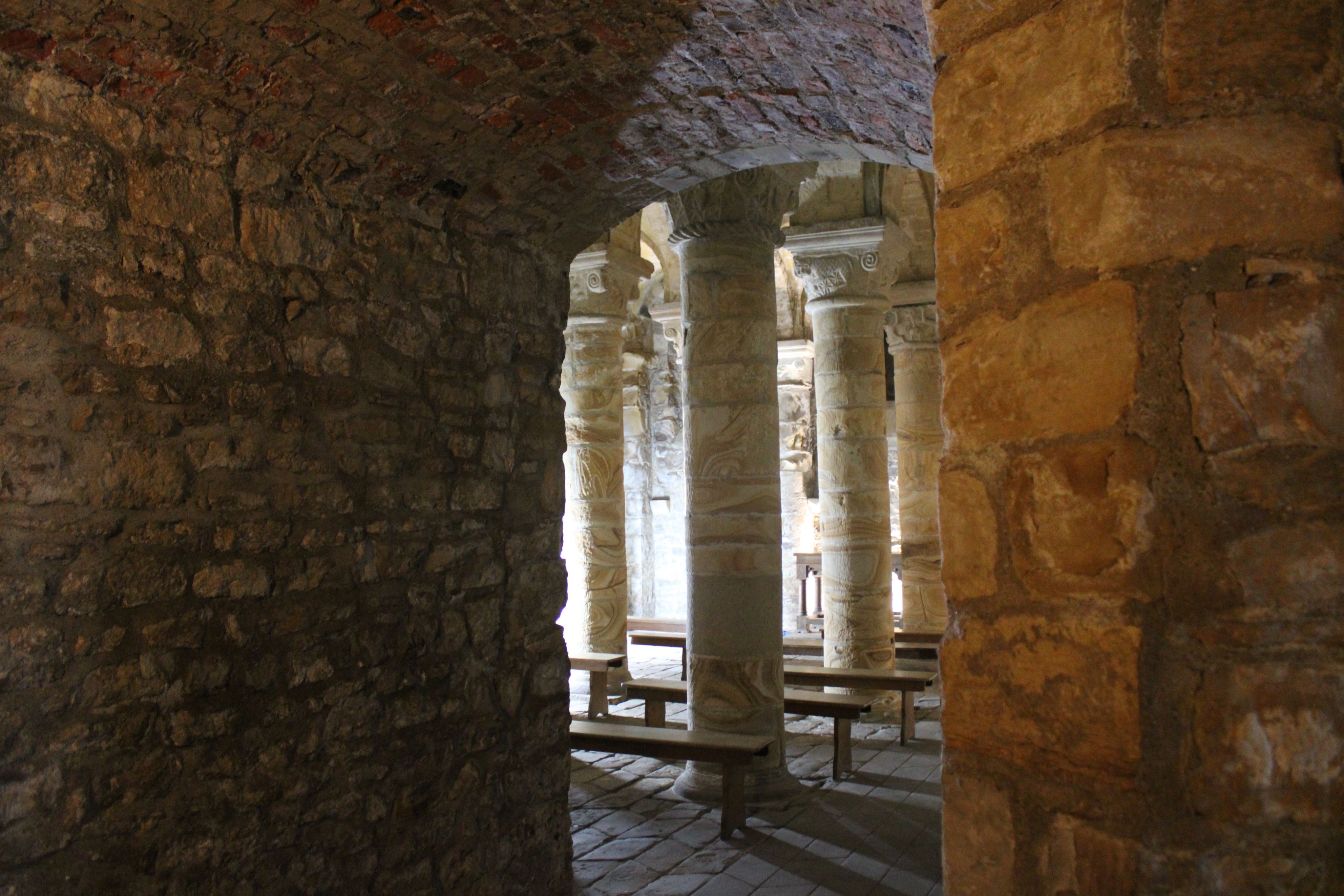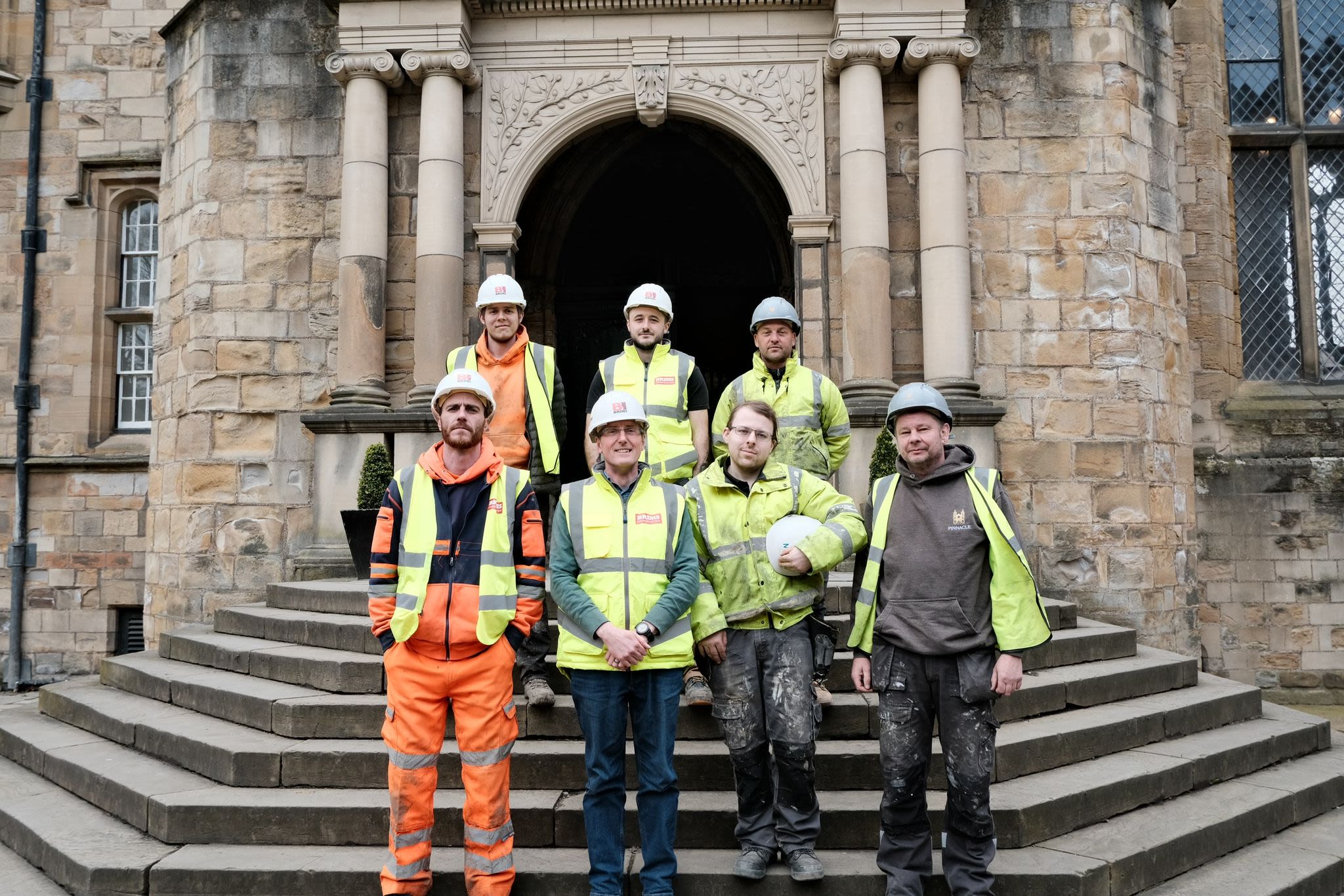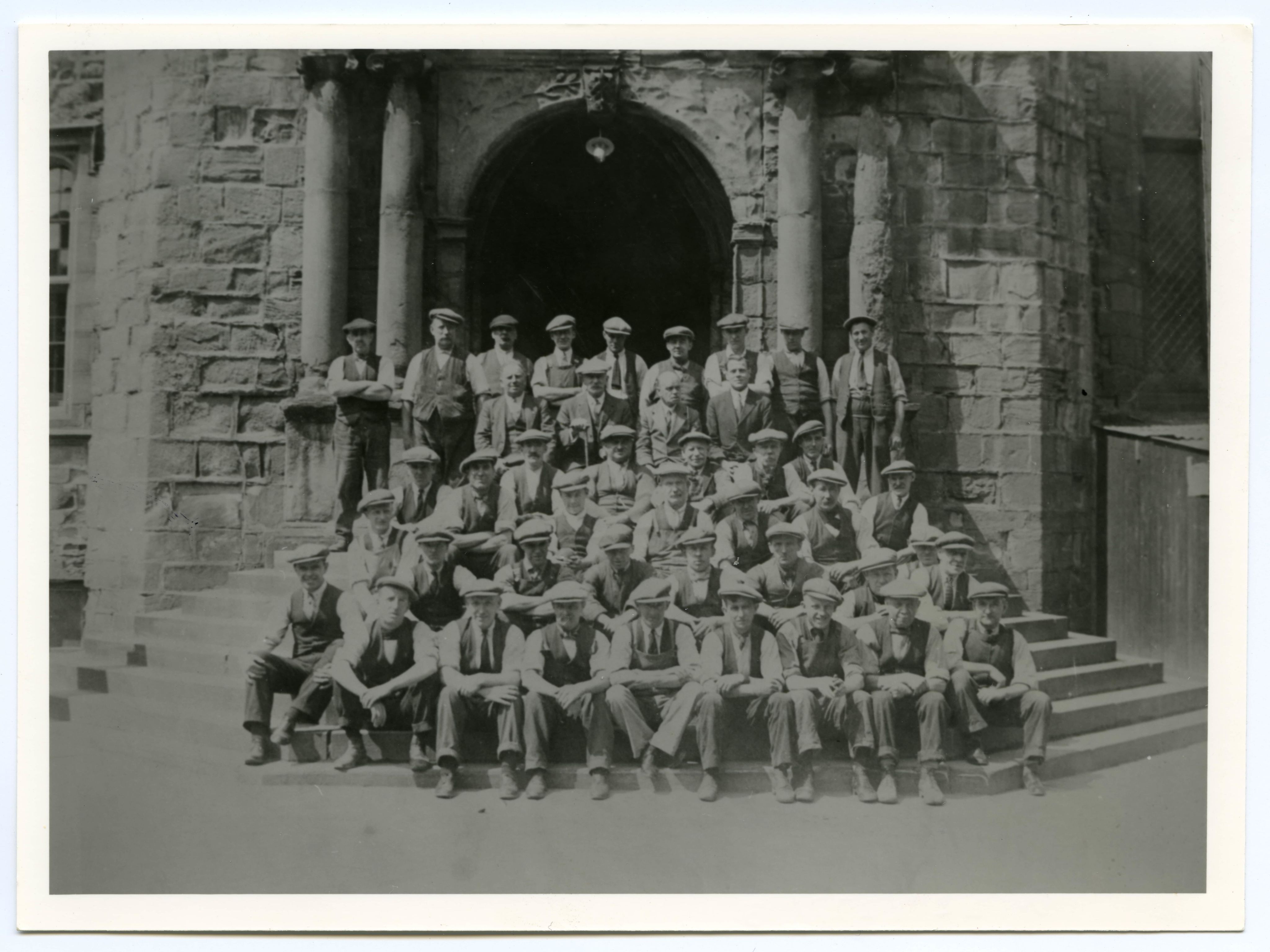Repair and Care

Pillars of the Past
A Chapel Hidden Through History
The Norman Chapel was constructed by Bishop St Calais circa 1080 and is situated in the castle beneath the Tunstall Gallery. It is the oldest standing building in Durham city and this exhibition explores how it has achieved this title through conservation efforts, community, and historical significance. Within the castle walls lie a collection of invaluable artefacts spanning different eras, each carrying exciting stories that follow the Chapel’s journey through time.
If you stepped into the space at different points on history, you would be greeted by a new scene each time. When it was created beams of light would filter in through the high windows, illuminating the capital carvings and creating a heavenly aura. Candles hung from the ceiling would also provide this feeling when natural light was limited in the winter.
Once you reach the 12th century you would be unable to reach the chapel as Bishop Flambard blocked the entrance by building the North Hall. To get inside you would have to be a Durham University student in 1840, running up to your accommodations through a staircase in the chapel. The space would only return to being a working chapel after a short life as a Royal Airforce command post during the Second World War.
Today it serves a variety of purposes: from a student theatre to a building that explores the importance and process of historical conservation.
Laurence of Durham
One of the earliest references to the Norman Chapel is a 12th Century Poem by Laurence of Durham. It reads, “And here stands a glorious chapel, supported by six columns. Not too spacious, but beautiful enough.” His simple summary still works today even though the Chapel has gone through many changes since he last saw it.
Do you love sneaking in and out of the darkness between the rocks of the Chapel to see the stars? Don't forget your kittens, take them with you to explore the world!
Prayer Book
This book was most likely used in the Tunstall Chapel, just above the sleeping Norman Chapel that was closed from the 12th century until 1840. This leather-bound book titled “Durham Chapel,” was used to deliver prayers and give religious instructions within the castle. The book was printed by the king’s printer, John Baskett, in 1739.
‘Strive to enter in at the strait gate'.
Luke 13:24 (KJV)
You will have to enter in at some strait gates when you in the Castle!
Royal Airforce Book
From 1941 to 1946 the Norman Chapel served as a Royal Airforce observation and command post. After the war, the space circled back to being a working chapel, but also became a memorial dedicated to those who lost their lives in the Second World War. This book keeps the records of those who trained at Durham Castle before going to war.
From here to the battlefield and back again ... leave the world behind you for a while and go chase butterflies!
UNESCO Certificate
The World Heritage Committee officially listed Durham Castle and Cathedral on the The World Heritage List in 1986. Inscription on this list confirms the exceptional and universal value of a cultural or natural site which requires protection for the benefit of all humanity.
Conservation and Care
What is Conservation?
Conservation is the preservation of physical history. This work is often carried out by specialist conservators, dedicated to preserving pieces of the past. As buildings and objects age or are exposed to external forces, they begin to fall apart or become damaged. It is the job of a conservator to find ways to repair and prevent further damage. Conservation helps ensure that the Norman Chapel can be studied and enjoyed now and in the future.
The Chapel is currently undergoing a £2.5 million conservation effort to prevent the total decay of the building’s structure. The Norman Chapel Project is a collaborative effort with conservators, construction professionals, curators, and archaeologists dedicating their expertise to the preservation of the Chapel for future generations.
The Science Behind It
The Chapel is made of sandstone that is slowly eroding due to water seeping into the rock. To prevent the structure from collapse, a trench has been dug to let the outer part of the Chapel ‘breathe’. This will separate the damp earth from the stone and allow the moisture to escape. To repair the damage, conservators are working to make a mixture of mortar that will better support the sandstone blocks.
Slate Brick
This slab of slate was probably used for roofing. This was found by archaeologists at the Norman Chapel dig site with a broken nail hanging on one edge. It is like those used in Victorian and early 20th century construction.
Sandstone
A block of sandstone from the ongoing construction of the Norman Chapel. Sandstone is easily eroded by moisture which creates the curving hollows seen on damaged stones in the Norman Chapel.
The current construction team as of 2024, who are leading the Norman Chapel Project
The current construction team as of 2024, who are leading the Norman Chapel Project
Craftsmen and Labour
A Historic Tapestry
Builders are important to the construction and conservation of the Norman Chapel. Over the past 900 years the role of the builder has evolved thanks to new methods and technology. This part of the exhibition explores the dedicated people who built and preserve the Norman Chapel from past to present.
When the Chapel was built in the 11th century conditions on site were dangerous, resulting in a high number of casualties. Labourers received little or no pay for manual work, carrying materials on their backs and digging foundations by hand. Skilled workers such as plasterers, stone cutters, and mortar makers were considered craftsmen. They took great pride in their work and were paid according to skill and experience.
The current builders on the Norman Chapel project work as both conservators and constructors. Their work is in collaboration with those of the past to preserve the Chapel’s historic details for present, and future generations.
Builders and Protective Clothing
Today’s construction workers use high visibility clothing to prevent accidents. It has become the uniform of the modern construction worker and a compulsory on site precaution. The builders of the original Norman Chapel probably wore natural materials which were readily available like linen and wool. During the Victorian period builders often wore thick tweed clothing. Tweed not only provided warmth, but the densely woven fabric was also used for its water-resistant qualities and protection in inclement British weather.
Walk around, you will see all the cracks in the walls and signs of construction from different eras in Durham Castle. The time is shaped by your hands here.
Photograph of the builders who worked on Durham Castle in 1929 posed outside of the Castle’s main entrance. Image courtesy of Durham County Record Office.
Photograph of the builders who worked on Durham Castle in 1929 posed outside of the Castle’s main entrance. Image courtesy of Durham County Record Office.
The current construction team as of 2024, who are leading the Norman Chapel Project
The current construction team as of 2024, who are leading the Norman Chapel Project
Construction and Archaeology
Never One Without the Other
Durham Castle became part of the newly established Durham University in 1836. Since then, it has seen various construction projects. Each project has brought new archaeological finds, increasing our understanding of the Castle’s history.
Archaeological research is given a central position in the management and construction plans that guide many World Heritage Sites including Durham Castle. The key aims of these plans are to safeguard cultural heritage through conservation, educate the public on important histories, and protect potentially significant sites from destruction.
Games & Coins
Silver Coin
This worn silver halfpenny was found during the archaeological work at the Norman Chapel. The original penny would have been deliberately cut in half to decrease its value to make a smaller purchase. The irregularly shaped edges on the coin suggest that it may have been illegally clipped to harvest spare silver.
Bone Dice
This bone dice has an unusual arrangement for a medieval dice. Typically, medieval dice are numbered so that the opposite sides add up to seven. This dice is more typical of Roman style dice, where opposite sides of the dice do not add up to seven. It was found alongside medieval finds, suggesting that this Roman dice was used up until the medieval era.
It could have been used to play mediaeval games such as Hazard where a person threw a die after saying the number they wanted to roll. If the person rolled that number, everyone playing had to pay them, but if they failed, they had to pay everyone else.
Food, Banquets, and Pets
Living it up in Durham Castle
Archaeologists study historic diets by uncovering remnants of bone, dishware, fossilised plants, and even ancient recipes. As the former home of the Prince Bishops of Durham, the Castle hosted many extravagant banquets. These archaeological finds can tell us about dining traditions at the Castle through time.
The discovery of animal remains can help us piece together stories of past environmental conditions, agricultural patterns, and even historic pets. We can also learn from images of and references to animals that decorate a range of artefacts.
From the large amount of animal remains found at Durham Castle we know that people enjoyed a rich and varied diet through hunting and farming that included cattle, sheep, and pigs. Archaeological records suggest that these were the most prominent animals consumed at the Castle, showcasing the vital role these animals had in daily life.
Fish Bones
Many archaeological surveys at Durham Castle have found large amounts of fish bones. This suggests that fish was a dietary staple from at least the Medieval Period. The fish were likely caught at sea or in the river and transported to the Castle.
Raven Bone
This is a raven's scapula or shoulder blade. It shows signs of a previous breakage that was healed. The fractured bone would have affected the raven's ability to fly, meaning that it may have received care for some time to allow the bone to mend. This species could be a companion animal, comparable to cats and dogs.
Is there a soul inside the bone?
Does a companionship end with death?
Paw Print Ceramic
This piece of pottery appears normal at first glance, but it also hides a special story. Every pet owner has seen this design stamped across the floor at one point or another: a paw print! Whether the paw was pressed into the wet clay, or someone carefully copied the shape, this is evidence of humanity’s age-old love for our four-legged friends.
Have you seen the ghost of a dog? Or was it a cat? You should catch that furry fellow and check its paw!
Your feedback is important to us. Please take a moment to complete this short feedback form.

















